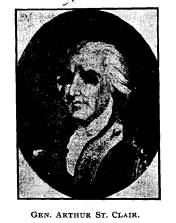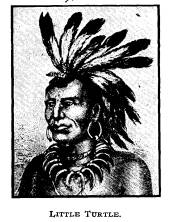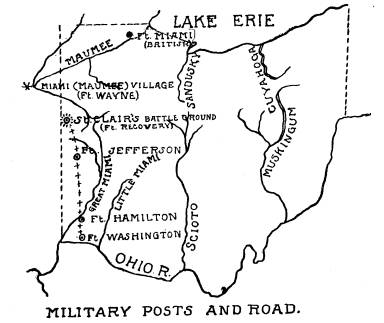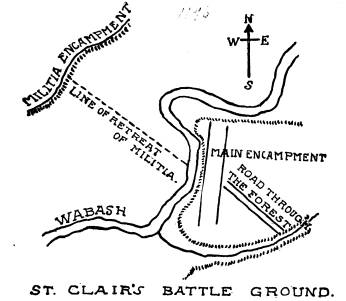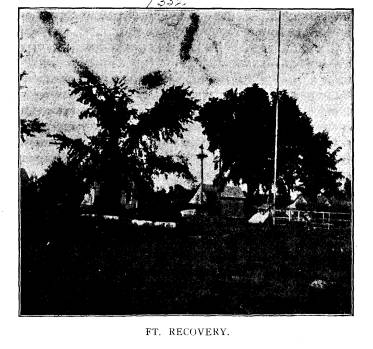Ohio History Journal
|
ST. CLAIR'S DEFEAT.
FRAZER ELLS WILSON, GREENVILLE, OHIO. [Author of the valuable little volume, entitled "The Treaty of Greenville," published 1894.-E. 0. R.] Probably the most disastrous defeat ever suffered by the Americans at the hands of the Red Men was that of the army of Gen. Arthur St. Clair on the east branch of the Wabash near the present western boundary of Ohio, November 4th, 1791. Both |
|
|
|
for the number of men killed and the blighting effect on the frontier settlements was this disaster noted and the first report of it cast a pall over the new nation. The tide of white immi- gration which had begun to flow over the crest of the Alleghenies just at the opening of the Revolution, was greatly augmented after its close when the survivors of that great struggle who had sacrificed their all for liberty turned their faces from the older communities of the East to the promising lands of the West. Considerable settlements were being made in southwestern Penn- sylvania, in western Virginia around Wheeling, and the mouth of the Kanawha, and in Kentucky below the Licking river. The settlers built stockades and blockhouses, cleared small tracts of (30) |
St. Clair's Defeat. 31
the dense wilderness for the plow and
lived the rude life of
the frontiers in constant menace by the
hostile Indian tribes, who
viewed this steady invasion of their
ancient hunting grounds with
jealousy and alarm. In 1787 the famous
"Ordinance" providing
for the organization and government of
the "Territory North-
west of the river Ohio" was passed
by Congress, and the tide
of immigration soon turned in this
direction. In 1788 Marietta
was founded by a company of New
Englanders and became
the capital of the territory. In a few
years Gallipolis, Man-
chester, Columbia and Fort Washington
(Cincinnati), dotted
the northern shore of the Ohio.
Early in 1790 Arthur St.
Clair, who had served with dis-
tinction in the French and Indian War
and the Revolution, was
appointed governor of the newly
organized territory. Scarcely
had he set the wheels of government in
motion when reports of
Indian attacks along the frontier kept
coming in. The tribes
along the Wabash and the Maumee (Miami
of the Lakes) were
especially hostile and were probably
assisted and goaded on
by the British agents at Detroit and Ft.
Miami, who wished to
retain their favor and discourage the
extension of the American
settlements. In order to deal the
savages an effective blow,
Gen. Harmar of the U. S. Infantry, was
instructed to lead an
army of about 1200 frontier
militia and mounted riflemen against
the Maumee villages while Major
Hamtramck, the commander
at Vincennes, was sent against the
Wabash towns with a much
smaller force. The latter officer soon
succeeded in destroying
some of the villages and a quantity of
corn without any serious
engagement and returned to Vincennes.
Harmar's force left Ft.
Washington September 30th via Miami
Valley and arrived at
the Maumee towns, near the present site
of Ft. Wayne, Indiana,
on the 17th of October, marching about
10 miles per day. By
the 21st the chief town, several other
villages and probably
20,000 bushels of corn had been destroyed. Two or three at-
tacks were made by detachments sent out
at different times,
but ended in failure and the army soon
returned to Ft. Wash-
ington, having lost about 180 men and
incited the savages to
further resistance. News of the late
disaster was soon spread
among the Northwestern tribes who now
united to make open
|
32 Ohio Arch. and His. Society Publications.
war. Little Turtle, chief of the Miamis, a warrior of great intelligence and prowess, who led the attack against Harmar and who had great influence among the western tribes, together with Blue Jacket, the great chief of the Shawnees and Buckon- gehelas, Chief of the Delawares, formed a confederacy of the northwestern savages to drive the white settlers beyond the Ohio. These chiefs, with the assistance of Girty, McKee and Elliott, the renegades, headed a band of warriors whose discipline has probably never been equalled in Indian warfare. Nothing but a decisive blow by a large and well disciplined force could quell |
|
|
|
the uprising being stirred up by these leaders. Accordingly Governor St. Clair was appointed a Major General in the U. S. army, March 4th, 1791, and placed in chief command of the forces to be employed against the Indians. The object of the main expedition planned by the goverment was to establish a post at the Maumee village for the purpose of awing and curbing the Indians in that region, and preventing future hostilities. The troops were to consist of two small regiments of regular in- fantry, two regiments of levies and 300 or 400 Kentucky militia. "The mounted men were to receive two-thirds of a dollar per day and to be under command of their own officers, while footmen were to receive three dollars per month and be subject to military law. It proved a difficult task to preserve harmony |
St. Clair's Defeat. 33
among the regulars and volunteers, as
the latter would scarcely
submit either to the discipline of the
army, or to the slow
movements which one having a road to cut
every step he ad-
vanced, and forts to build was
necessarily subjected to--neither
would they labor." While St. Clair
was getting ready or the
main campaign, the Kentuckians were
permitted to send two ex-
peditions of volunteers against the
Wabash tribes, with the view
of discouraging them from joining the
Miami tribes. The first
raid was made by Gen. Chas. Scott and
was soon followed up
by Col. Wilkinson. Both succeeded in
destroying corn and prop-
erty and cowing the Indians, but did
little else. An effort was
also being made in the meantime to
induce the Indians to peace
through the intervention of the friendly
Senecas. Col. Proctor
was sent out from Philadelphia on the
11th of March with in-
structions to proceed to the Miami
villages on the above mis-
sion. Proctor was to return to Ft.
Washington (Cincinnati, O.)
where St. Clair would receive him and be
prepared to conciliate
the Indians if possible. Negotiations
were delayed and the enter-
prise, it seems, ended in failure.
Preparations for the main expedition
were now pushed
vigorously but at great disadvantage.
Maj. Gen. Richard Butler
had been placed second in command with
orders to remain in
Pennsylvania to recruit and forward
troops. Two thousand
levies were to be raised, marched to Ft.
Pitt (Pittsburgh) in
companies as soon as collected, and
there receive orders from
St. Clair. They could be safely sent in
small companies but
were held back by Butler to protect the
frontiers according to
orders from the War Department but much
to the annoyance
of St. Clair, who kept urging that they
be sent to Ft. Wash-
ington. A Mr. Samuel Hogdon had been
appointed Quarter-
master General of the army and, although
zealous, seems to
have been totally unfit for the
responsibilities of the position.
The delay in forwarding troops was also
partly due to his failure
in furnishing horses, supplies,
provisions, and the necessary boats
for transportation. St. Clair arrived at
Ft. Washington on the
15th of May after passing through
Lexington to arrange for the
forwarding of the Kentucky militia. He
found a garrison of
Vol. XI-3
34 Ohio Arch. and His. Society Publications.
but eighty-five men fit for duty here.
The arms and accoutre-
ments left from Harmar's expedition were
in a bad condition
and the supplies forwarded later by the
Quartermaster from time
to time were deficient both in quantity
and quality. New gun
carriages had to be made; the
deficiencies of the camp equipage
supplied; nearly all of the ammunition
had to be made up and
a laboratory equipped for this purpose.
Musket shells, artillery
cartridges, and shells for the Howitzers
had to be filled-a
tedious and laborious business. Not only
ammunition for the
campaign but also for the garrison of 1200 or more for
the
projected post at the Maumee and
intermediate posts must be
prepared. Workshops and an armory had to
be built and tools
constructed. In his report the General
said-"A great number
of axes, camp-kettles, knapsacks, kegs
for the musket cartridges,
and spare cannon ball, and boxes of
ammunition, had to be made;
and cordage of various kinds, and the
cartridge boxes to be re-
paired. Splints for the wounded were to
be made of half-
jacked leather prepared on the spot. In
short, almost every art
was going forward, and Ft. Washington
had as much the ap-
pearance of a large manufactory on the
inside, as it had of a
military post on the outside." To
perform all this labor smiths,
carpenters, harness-makers, colliers,
wheel-wrights, etc., had to
be drafted from all that could be found
among the troops as they
slowly arrived. Considerable cattle and
horses for the use of
the army had to be cared for and on
August 7th, the country
near the fort being eaten off, all the
troops that had arrived,
except the artificers and a small
garrison, advanced about six
miles northward to Ludlow's station. On
the 1st of September
the Secretary of War wrote to St. Clair:
"The President enjoins
you by every principle that is sacred to
stimulate your operations
in the highest degree, and to move as
rapidly as the lateness
of the season and the nature of the case
will possibly admit."
The balance of the troops, however, had
not yet arrived at the
above date but soon came on and joining
those at Ludlow's
station, moved on about twenty miles to
the Great Miami river
where a fort was built to command the
river crossing, to serve
as a place for depositing provisions,
and to form the first link in
the chain of forts projected between Ft.
Washington and the
St. Clair's Defeat. 35
Indian villages on the Maumee. St. Clair
described this post
in the following very interesting
manner: "A stockade fifty
yards square, with four good bastions,
and platforms for cannon
in two of them, with barracks for about
two hundred men,
with some good store houses,
etc." * * * "That circuit of
that fort is about one thousand feet,
through the whole extent
of which a trench about three feet deep
was dug to set the
picquets in, of which it required about
two thousand to enclose
it; and it is not trees, taken
promiscuously, that will answer
for picquets, they must be tall and
straight and from nine to
twelve inches diameter (for those of a
larger size are too un-
manageable) of course few trees that are
proper are to be
found without going over a considerable
space of woodland.
When found they are felled, cleared of
their branches, and cut
into lengths of about twenty feet. They
were then carried to the
ground and butted, that they might be
placed firm and upright
in the trench, with the axe or cross-cut
saw; some hewing
upon them was also necessary, for there
are few trees so straight
that the sides of them will come in
contact when set upright.
A thin piece of timber, called a
ribband, is run round the whole
near the top of the picquets, to which
every one of them is
pinned with a strong pin, without which
they would decline
from the perpendicular with every blast
of the wind, some
hanging outwards and some inwards, which
would render them
in a great measure useless. The earth
thrown out of the trench
is then returned and strongly rammed to
keep the picquets firmly
in their places, and a shallower trench
is dug outside about three
feet distant, to carry off the water and
prevent their being
moved by the rains; about two thousand
picquets are set up
inside, one between every two of the
others; the work is then
inclosed. But previously, the ground for
the scite of the fort
had to be cleared and two or three
hundred yards round it,
which was very thickly wooded and was a
work of time and
labour.
(The ground where this fort stands, is on the east
side of the Miami river, on the first
bank; but there is a second
bank considerably elevated, within point
blank shot, which ren-
dered it necessary to make the picquets,
particularly along the
land side, of a height sufficient to
prevent an enemy seeing
36 Ohio Arch. and His. Society Publications.
into the area, and taking the river in
reverse, and a high plat-
form was raised in one of the bastions
on the land side to
scour the second bank with artillery.
Another made with the
trunks of trees, and covered with plank,
as that was, was raised
in one of the bastions towards the
river, in order to command the
ford, and the river for some distance up
and down. Plank
was sawed for the platform and the gate,
and barracks for one
hundred men; a guardroom, two store
houses for provisions, and
barracks for the officers were
constructed within it and, all this
was done in about fourteen days, almost
entirely by the labour of
the men; though some use was made of
oxen in drawing the
timber, the woods were so thick and
encumbered with under-
wood, it was found to be the most
expeditious method to carry
it.") This post was named Ft.
Hamilton.
The main part of the army, consisting of
two small regi-
ments of regular infantry, and the
levies, about two thousand in
all, left this place October 4, and were
followed on the 5th by
about 300 Kentucky militia. St. Clair,
in describing the march-
ing order of the troops, observes:
"When the army was in
march, it was preceded by a small party
of riflemen, with the sur-
veyor, to mark the course of the road;
for we had no guides,
not a single person being found in the
country who had ever been
through it, and both the geography and
the topography were
utterly unknown; the march was,
therefore, made up on a com-
pass course, conjectural indeed, but
which proved to be suffi-
ciently correct, as it brought us into a
large path leading to the
Miami towns about twenty miles from
them; from that party
scouts were sent out to scour the
country every way; then fol-
lowed the road cutters with a party to
cover them; then the
advanced guard, and after them the army
in two columns, with
one piece of artillery in front, one in
the center, and one in the
rear of each. In the space between the
two columns marched
the remaining artillery, destined for
the fort at the Miami towns;
then the horses with the tents and
provisions, and then the
cattle with their proper guard, who were
to remove them in case
of the enemy appearing. Without the
columns, at a distance of
about one hundred yards, march the
cavalry in file, and without
them, at the same distance, a party of
riflemen, and scouts with-
|
St. Clair's Defeat. 37 out them; then followed the rear guard at a proper distance." Roads for the artillery had to be cut through the thick timber nearly all the way and some considerable bridges built. Pro- gress was necessarily slow and by the 13th, the army had ad- vanced but 44 miles from Ft. Hamilton. Finding a suitable place, a halt was made and the work of erecting another post entered into. This fort was about 100 feet square, with four good bas- tions and was built of logs laid horizontally, the walls forming the outer sides of the soldiers' barracks. It was garrisoned by a small detachment, two pieces of artillery left in it and given the name Fort Jefferson. The plan of encampment here is shown in the illustration below, the artillery and cavalry being in two lines divided upon the flanks and the riflemen at right angles on the sides: |
|
|
|
While the work was going on at this place, Gen. Butler, who was second in command, proposed to St. Clair that he be allowed to take 1,000 picked men and go to the Maumee villages, and |
38 Ohio
Arch. and His. Society Publications.
there establish the projected post,
leaving the Commander-in-
Chief to finish the fort and follow at
his leisure. The season was
late, and as St. Clair was advanced in
years and very much in-
disposed at times by attacks of the
gout, this was proposed,
ostensibly to relieve him and hasten the
consummation of the
campaign. The General, however, was very
disagreeably sur-
prised by the proposition and refused
the proffer. Butler seems
to have taken offense at the rebuff and
grown more reserved
in his relations with St. Clair,
although the latter thought that
his own action was a proper and due
exercise of his power as
head of the army.
On the 24th of October the troops
marched about six miles,
still following the same Indian trail,
and camped on the present
site of Greenville, Ohio, a creek being
in front and a large prairie
on the left which afforded excellent
forage for the jaded horses.
Here the army halted a week awaiting
provisions and sending
out spies to ascertain the whereabouts
of the Indians. On the
30th the march was continued seven
miles, the direction changing
to 25 degrees west of north. On the 31st
sixty of the Kentucky
militia deserted, threatening to plunder
the second convoy of
provisions which was then thought to be
within twenty miles
on the trail. In order to save the
supplies which were necessary
for the sustenance of the army, and to
prevent further desertions,
the whole of the first regiment of
regulars was detached, and sent
back. The quartermaster had failed to
start the convoy at the
appointed time, however, and this
regiment was separated from
the main body by a greater distance than
anticipated, thus re-
ducing the effective fighting force to
about 1,400 men. On No-
vember I the army halted to allow the
road-cutters to get some
distance ahead. A few Indians had been
observed hanging about
the flanks of the army and on the 3d
a larger number than usual
were noticed. After a hard march through
the cold on short
rations the army arrived about sunset on
that day at a small
stream flowing southward, which was
supposed to be the St.
Mary's, a branch of the Maumee, but was
in fact a branch of
the east fork of the Wabash. Here an
encampment was made
in two lines on a slightly elevated
piece of ground with the
creek in front and on the right and a
ravine on the left. The
St. Clair's Defeat. 39
first line was composed of Butler,
Clarke and Paterson's bat-
talion of levies, and commanded by Gen.
Butler. The second
consisted of Bedinger and Gaither's
battalions and the second
regiment of regulars commanded by Lieut.
Col. Darke and was
about 200 feet to the rear
of and parallel with the first. The
right flank was protected by the creek;
the left by a steep bank,
Faulkner's corps and some of the
infantry. The militia advanced
about a fourth of a mile across the
creek bottom and camped
on high ground. It had been a hard day's
march and was near
8 o'clock before the scanty mess was
cooked. The soldiers, tired
and worn, were soon sleeping heavily.
Capt. Slough of the 1st
battalion of levies was sent out with a
small number of picked
men with instructions to advance one,
two or three miles along
the trail in search for Indians. About
midnight they returned,
with the report that they had fired on a
party of six or seven
savages, killing one, and had been
passed by a much larger party
later going towards the camp. The
report, according to Capt.
Slough's testimony, was made to Maj.
Gen. Butler, who then
dismissed him for the night without
instructions to inform St.
Clair. Col. Oldham of the militia also
predicted an attack in
the morning. Gen. St. Clair had observed
on the afternoon pre-
vious that he did not expect an attack
yet and in the evening
concerted plans with Major Ferguson of
the artillery for throw-
ing up a small earthwork, wherein to
have deposited the knap-
sacks and heavy luggage. He then
intended to make a forced
march to the Maumee village, which he
thought to be about
15 miles,
but which was in fact very much farther, as soon as
the first regiment came up.. He was
permitted to do neither,
for on the 4th before sunrise just after
the regular morning pa-
rade an attack was made on the pickets
of the militia across
the creek. A few shots were exchanged,
but fear seized the
Kentuckians, and they rushed pell mell
into camp, pursued by
a large party of Indians, whooping and
yelling fiercely. A volley
from the artillery in the front rank
drove them back to cover but
they soon renewed their fire and
gradually encircled the en-
campment, concealing themselves behind
trees, brush and fallen
logs and pouring in a galling fire. The
soldiers were cramped
for room and exposed because of the
nature of the ground on
40 Ohio Arch. and His. Society Publications.
which they were encamped and made an
easy target for the
savages who were expert marksmen. The
main fire was di-
rected against the men at the guns in
the center of the encamp-
ment and they were driven away again and
again with great
slaughter. This was kept up perhaps an
hour and a half until
nearly every officer of the artillery
had been killed or wounded
and all the guns silenced. The roar of
the artillery and rattle
of the muskets of the regulars may have
tended to awe the sav-
ages, but much ammunition was wasted by
the random shooting
of the untrained troops. Men were
falling in great numbers
in all parts of the camp, confusion was
spreading, and the In-
dians, becoming emboldened, swarmed
forward to seize the guns.
Previously they had flitted from cover
to cover under the pall
of smoke but now they became more
exposed at close quarters.
A spirited charge was made against them
under Col. Darke and
they were driven back across the creek
at the point of the bayonet.
For want of a sufficient number of
riflemen to follow up this
charge, they were forced to return and
were gradually followed
by the Indians, who pressed forward from
tree to tree and soon
came into camp on the left flank. Here
they were met by a
spirited charge from the second
regiment, Butler's and Clarke's
battalions, and pushed back. Again and
again was this repeated
but with great loss, especially of the
officers who had to expose
themselves to rally the raw and
undisciplined troops. In these
charges Major Butler was dangerously
wounded and all the offi-
cers of the second regiment fell except
three. Both St. Clair
and Butler exhibited great bravery
throughout, the former hav-
ing had two or three of his horses
killed and several bullet holes
shot through his clothes; the latter
having been mortally wounded,
continued to give orders while propped
up in the center of the
camp. The fire was continued nearly
three hours until the ma-
jority of the officers and half of the
army were either killed or
wounded. The soldiers crowded to the
center of the camp, be-
ing pressed gradually closer from all
sides by the exulting sav-
ages. The remnant of the army became
stupefied and bewil-
dered and it became necessary to order a
retreat. Accordingly
Col. Darke was ordered to make a charge
and with a number of
the best men made a feint driving the
Indians beyond the road
and making an opening through which the
balance of the troops
|
St. Clair's Defeat. 41
hurried pell mell with the militia in front. The Indians had been thrown into confusion by the charge, but, discovering its object, soon pursued the struggling army along the trail and harassed the rear for three or four miles. Attracted by the rich booty, however, they soon returned to plunder the camp and kill or torture those of the wounded who had been left on the field. Here a sickening sight presented itself. Huddled in a compara- tively small space were piles of the slain on the frozen ground, |
|
|
|
the silent cannon, the deserted tents and valuable camp equip- ments all abandoned in the flight for life. While the Indians were securing their plunder and gloating over their victims, the routed army continued its retreat and kept throwing away arms and equipments in the panic of fear. Nearly all the horses had been taken or killed and St. Clair, mounted on a slow pack-horse, was unable to reach the front himself and the other officers found it impossible to establish order and check the flight. The rout continued along the road to Fort Jefferson, a distance of about 30 miles, where the men arrived just after sunset. Here the first regiment, which had been sent back to intercept the desert- ers, was met, but in view of the broken condition of the troops, |
42 Ohio Arch. and His. Society Publications.
the lack of provisions in the fort and
the strength of the enemy,
it was decided to continue the march
toward Fort Washington
on the next morning with the prospect of
meeting a convoy on
the way.
The number of Indians in this engagement
has been variously
estimated at from 700 to 2,500 or 3,000,
but 1,000 or 1,500 is con-
sidered a conservative figure, and the
amount of government
property either lost or destroyed is put
at more than $34,000.
Little Turtle, chief or the Miamis, was
their leader and their loss
was estimated at about 150 killed and
several wounded, but be-
cause of their custom of carrying away
or concealing the slain
it is difficult to ascertain the number
of their slain. The Ameri-
cans had thirty-nine officers killed,
and twenty-two wounded, and
their entire loss was estimated at 677
killed, including 30 women,
and 271 wounded. Among the
prominent officers killed were Gen.
Richard Butler, Maj. Ferguson of the
artillery, Col. Oldham of
the militia, Maj. Clarke and Maj. Heart;
and among the wounded
were Col. Sargent (the Adj. Gen.),
Lieut. Col. Gibson, Major
Thos. Butler, and the Viscount Malartie,
aide de camp to St.
Clair.
The new government was experimenting in
Indian warfare
and had much to learn. Washington had
been present at Brad-
dock's defeat and had warned St. Clair
before departing. The
latter sent his aide, Major Denny, with
the news of his defeat to
the President at Philadelphia. On
account of the ice in the Ohio
River and the bad condition of roads it
took twenty days to
reach Wheeling and ten more to reach the
capital. President
Washington received the dispatch while
eating dinner, but con-
tinued his meal and acted as usual until
all the company had gone
and his wife had left the room, leaving
no one but himself and
Secretary, Col. Lear. He now commenced
to walk back and
forth in silence and after some moments
sat down on a sofa. His
manner now showed emotion and he
exclaimed suddenly: "St.
Clair's defeated-routed; the officers
nearly all killed, the men
by wholesale, the rout complete! too
shocking to think of-a sur-
prise in the bargain." Pausing
again, rising from the sofa, and
walking back and forth, he stopped short
and again broke out
with great vehemence: "Yes! here on
this very spot I took leave
of him; I wished him success and honor.
'You have your in-
|
St. Clair's Defeat. 43
structions,' I said, 'from the Secretary of War; I had a strict eye to them, and will add but one word, beware of a surprise! you know how the Indians fight us! He went off with that as my last solemn warning thrown into his ears. And yet, to suffer that army to be cut to pieces-hacked by a surprise, the very thing I guarded against! . . ." The President again sat down on the sofa and his anger subsided. At length he said: "This must not go beyond this room." After a while he again spoke in a lower tone: "General St. Clair shall have justice. I looked hastily through the dispatches-saw the whole disaster, but not all the particulars. I will hear him without prejudice, he shall have full justice." A committee of the House of Repre- sentatives investigated the cause of St. Clair's defeat and ac- quitted him with honor. He afterwards served as the first Gov- ernor of Ohio and died at Greensburg, Pa., in 1818, at an ad- vanced age and in comparative poverty, having seen the final overthrow of the hostile tribes and the permanent founding of civilization in this matchless region of the old Northwest. |
|
|
